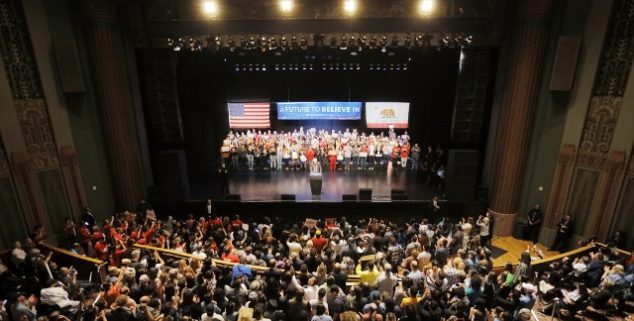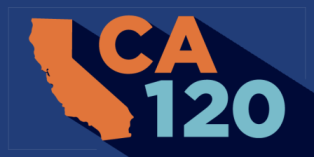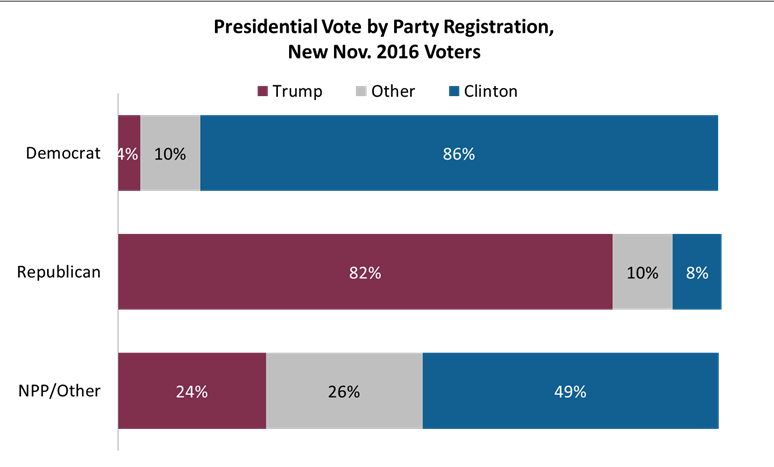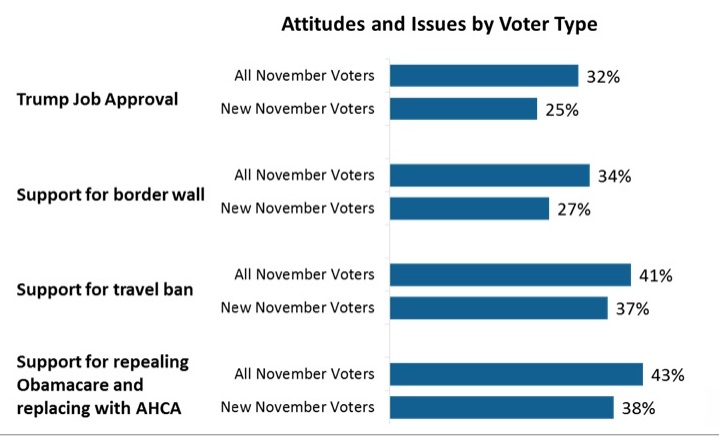News
CA120: Will those new 2016 voters return for the midterms?
 A March 2016 rally in Los Angeles for Democratic presidential candidate Bernie Sanders. (Photo: Joseph Sohm)
A March 2016 rally in Los Angeles for Democratic presidential candidate Bernie Sanders. (Photo: Joseph Sohm)History tells us that presidential-year new voters are likely to skip mid-term elections. Will the new voters of 2016 be any different?
The answer to that question could have a profound impact on the 2018 elections.
A new poll, released this week by EMC Research (www.emcresearch.com) and Capitol Weekly, dives into these new registrants with a deep look at their interest in elections, how they receive political information, their ideological and policy leanings, how they view the current Trump administration and what they want our state’s leadership to do about it.
California’s voter registration surge in 2016 was unprecedented. The state set a registration record in the primary with more than 2 million registrations, then set another record in the general election for a total of 5.4 million new and re-registered voters in just 11 months.
This surge accounted for more than a quarter of the state’s voter file. Nearly 40% of all households in the state had someone who had recently completed a voter registration.
As we have reported earlier, these newly registered voters did turn out in significant numbers, and in higher numbers than other voters in their age group.
For example, the average registrant in 2016 was roughly 29 years old, but turned out at a 78% average – that’s higher than the 74% total turnout rate, and much higher than the 60% turnout rate for all voters under 35.
There are two key questions for campaigns going forward:
–Are this new wave of registrants going to stay engaged in elections, or will they tune out until the next presidential election?
–Is this new wave of registrants reflective of the overall voter file in attitudes, political ideology and values?
In 2012, we analyzed voters who participated in that presidential election and had registered for the first time in the large registration and participation surge in 2008.
In that analysis we found that 30% of the new registrants skipped all the intervening elections, including the 2010 gubernatorial election and any local municipal contests in those four years. For those under 35 years old, 43% skipped all intervening elections.
A similar look at the voters who first registered in 2012, and then voted again in 2016 shows even lower participation in non-presidential elections, with 57% skipping all intervening elections, and a 65% nonparticipation rate for voters under the age of 35.
These prior examples would suggest a depressed turnout for the 5.4 million 2016 registrants heading into the 2018 governor’s race.
And the L.A. County elections in March of this year provide even more evidence. While the city had extremely low turnout at just 17%, the turnout for 2016 registrants was an even more anemic 8%.
The new EMC Research survey was conducted among a random sampling of the 2.45 million California voters that registered in 2016 and do not have any prior vote history in the state. They represent 13% of all registered voters in California, and 68% of them voted in November. The poll also included a control sample of randomly selected November 2016 voters for comparison purposes.
Some highlights of the poll follow, but you can click here for more details.
New registrants who voted in November report high interest and engagement:
—75% say they are following politics more closely since the November election
–26% say they have contacted a lawmaker and 28% say they have marched or protested since the election
–80% say that they followed November elections for state ballot measures very or somewhat closely
–59% say they followed elections for state assembly or state Senate
–63% say they followed elections for local candidates and ballot measures
–45% are highly interested in the 2018 elections, and another 31% are at least somewhat interested
New registrants remember seeing media about the election – mainly on TV and social media
—42% remember frequently seeing information on TV about the election, another 39% remember seeing something occasionally (81% total recall)
–51% remember frequent social media posts, another 34% remember seeing something occasionally (85% total recall)
–Total recall of online ads is 81%, with 30% saying they received ads frequently
— Total recall of mailers is lower at 69%, only 20% of new registrants say they frequently received mail

Not all new voters were Democrats voting for Clinton.
—Over half, 58%, of new registrants indicated that they voted for Hillary Clinton, 25% voted for Trump.
–Not surprisingly, 86% of Democrats voted for Clinton and 82% of Republicans voted for Trump.
–Among NPP voters, 49% voted for Clinton and 24% Trump
–Many (30%) of new voters say they cast their vote primarily against Trump, as opposed to 28% that voted primarily for Clinton. Fifteen percent say they voted for Trump and 10% voted against Clinton.
–Newly eligible voters report the highest level of anti-Trump sentiment with 41% casting their ballot for that reason.

Importantly for California campaigns, not all new registrants are the same. The survey identified three distinct categories of new registrants.
Newly eligible voters – This group broke for Clinton by a greater margin than other new voters, and is disproportionately Latino – 42%, compared to 23% of the overall November electorate. This group is the least engaged and attentive to politics and least likely to participate in non-presidential elections.
Newly engaged voters – At just over half of November’s new voters (52%) this group is the wild card for predicting engagement in mid-term elections. They are young – 46% under age 35, (compared to 22% of November voters overall) and 43% are registered with No Party Preference (compared to 26% of November voters.) Just under half of them express strong interest in 2018 elections, compared to 65% of November voters overall.
Self-reported prior voters – These voters, who make up 24% of new registrants who voted in November, have no vote history on file, but report they are regular voters and re-registered because of a move. This group is very similar to the overall presidential electorate in attitudes, ideology, attention to political news and elections, and interest in the 2018 elections, but is somewhat younger and less partisan than the overall presidential electorate. It would be a mistake for campaigns to overlook this group by leaving out all 2016 new registrants from voter contact and turnout efforts, but quality turnout models and analytics will be needed to identify them. 
New voters are more progressive and more opposed to the Trump administration than overall November voters. In addition to supporting Clinton in greater numbers, new voters are more progressive in their attitudes and issue positions. New voters include slightly fewer registered Democrats (43% compared to 46% of November voters overall) but also significantly fewer Republicans (17% compared to 28% of November voters overall). Nearly half (46%) consider themselves liberal, similar to 47% of November voters overall; but fewer are conservative 24%, compared to 30% of November voters overall. New voters give Trump a 25% job approval rating and oppose Trump’s border wall, travel ban and health care plan – in all cases, opposition to Trump’s position is stronger among new voters than November voters overall.”
—-
Ed’s Note: The EMC Research/Capitol Weekly poll surveyed 888 California voters (margin of error – 3.3 percentage points), plus an additional 1,504 voters who registered in 2016 to vote in the presidential election (margin of error – 2.5 percentage points). Voters were interviewed online from April 4-18, 2017. For additional detail, visit here.
Want to see more stories like this? Sign up for The Roundup, the free daily newsletter about California politics from the editors of Capitol Weekly. Stay up to date on the news you need to know.
Sign up below, then look for a confirmation email in your inbox.

Leave a Reply